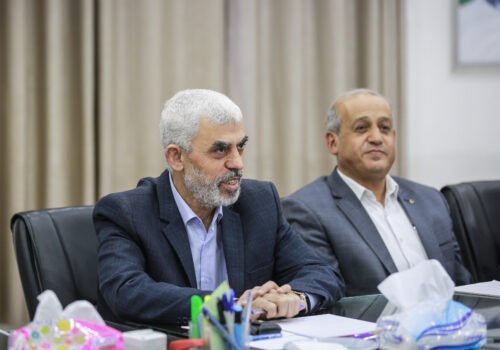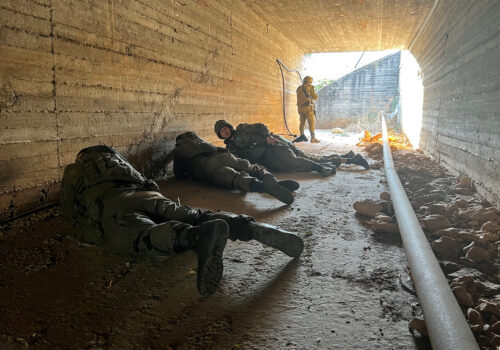With few options left, a limited peacekeeping force in Gaza could be the answer
Almost nine months after the horrific events of October 7, 2023, and the ensuing war against Hamas’s rule in Gaza by the Israeli military, the strategic picture has not changed in a way that Israel and its allies wanted. While Hamas is, in fact, weakened tactically and operationally, the group has not been strategically defeated and remains present throughout the strip—even in areas cleared by Israel Defense Forces (IDF) troops. The Islamist group’s total defeat, which Israeli Prime Minister Benjamin Netanyahu has long promised to deliver, remains elusive. So does the full release of all remaining hostages in Gaza, whether alive or dead.
The proposed ceasefire and hostage exchange deal, recently championed by the Joe Biden administration on May 31, has failed to move forward. It faces opposition from a hesitant Hamas that is dragging its feet, and from an intransigent Netanyahu who just declared he is backing away from the proposal, saying that he’s okay with exchanging some hostages but wants to resume the war after a pause. While some “day-after” scenarios have been proposed for what follows the war’s end, no progress has been made in establishing real and viable plans for who governs Gaza after the war or for a meaningful exit strategy for all parties involved.
There appears to be an unspoken alignment between Netanyahu and Hamas’s leader in Gaza, Yahya Sinwar, to keep the war going in a manner that serves both parties’ divergent interests. Netanyahu is more likely to escape accountability for the shortcomings and grave miscalculations that resulted in the October 7, 2023 attack’s catastrophic success, arguably the worst single security failure on Israel’s territory. Furthermore, the chances of Netanyahu maintaining political power and avoiding early elections are greater with a protracted war in Gaza, a view that has become mainstream within Israeli society and politics. The Biden administration also seems to be aware of this reality, which is why the United States hosted opposition leader Benny Gantz and invited Defense Minister Yoav Gallant to Washington on June 23 to explore viable options beyond Netanyahu’s narrow interests.
SIGN UP THIS WEEK IN THE MIDEAST NEWSLETTER
Sinwar and the hardline military commanders of Hamas, on the other hand, may have realized that a perpetual war in Gaza, even a low-intensity one, would ensure Hamas’s political and geo-strategic relevance and survival as a resistance movement. Should the war persist without an end in sight, the Israeli military is likely to maintain some presence in Gaza, allowing the Islamist group to engage in a protracted insurgency that would afford Hamas credibility and clout within Palestinian politics and the broader Arab and Muslim worlds. Should this happen, Sinwar might rid Hamas of the headache associated with governing Gaza, which proved difficult for the group amid perpetual blockades, financial sanctions, and limited resources for fulfilling the strip’s vast needs. This scenario would also outsource care for Gaza’s displaced and suffering civilians to the international community, which is currently the only source of humanitarian and medical support for the battered coastal enclave.
Netanyahu and Sinwar’s calculus would be disastrous for Israel and the Palestinians alike. The longer the war goes on, the more likely it is that a severe escalation with Hezbollah on Israel’s northern front will occur and trigger a broader war that could severely harm Israel militarily and weaken it strategically. Hezbollah’s capabilities are widely discussed as being vast and advanced, with the potential for wreaking extreme damage on Israeli cities and targets. In fact, Sinwar is likely hoping that a protracted war in Gaza increases the likelihood of a miscalculation in the north that could trigger a full-fledged war, which would consume Israel’s focus and attention—and increase regional instability in line with what Sinwar had hoped for in the first place when launching the October 7, 2023, attack. A wider conflict in the north also risks increased militancy targeting the Golan Heights through Iranian proxies in Syria and Iraq. Furthermore, scenes of destruction, widespread devastation, and loss of life in Lebanon will inflame tensions in the Arab and Muslim world, possibly destabilizing the fragile Hashemite Kingdom of Jordan, which has struggled with Islamist political forces seeking to exploit the war in Gaza to undermine the monarchy’s rule. The Arab League’s decision to drop Hezbollah’s terror classification foreshadows the likely setbacks in Arab-Israeli relations should the Israeli military destroy Lebanon in a war the way that it did the Gaza Strip.
A perpetual low-intensity conflict in Gaza—which appears to be the upcoming new phase that Netanyahu has recently described—is effectively a form of stalemate that keeps the war going at a limited scale, which fails to achieve strategic results while preventing the reconstruction of Gaza or the introduction of alternatives to Hamas’s rule. A protracted stalemate would be extraordinarily painful and challenging for the families of Israeli hostages and Gaza’s battered Palestinian civilians alike. Hamas has made it crystal clear that it will not agree to any hostage exchange deal absent a complete cessation of the war—a deal that hostage families and their allies are demanding to ensure the safe release of their loved ones. As for Gazans who have faced nine months of bombardment, displacement, and humanitarian crises, the continuation of the war in the manner envisioned by Netanyahu or Sinwar would become a disastrous new chapter in their suffering and elevate their level of hopelessness, which could trigger new waves of radicalization and unpredictability.
In the near term, it is difficult to envision a serious shift in Netanyahu and Sinwar’s attitudes toward the Biden ceasefire and hostage deal. Nevertheless, the administration should push for small steps that could plant seeds for transformation and sustainable stability in the Gaza Strip, even amid a potential stalemate. The United States, its regional allies, moderate Palestinian players, and the international community need a secure beachhead in Gaza that could serve as a measure of stability in a deeply unstable territory.
This beachhead should start with a limited peacekeeping force that has an extremely narrow mandate: deploying along the Gaza Strip’s borders with Israel and Egypt. Critically, this would help separate the Palestinians from the Israelis, prevent the establishment of an Israeli-occupied buffer zone inside Gaza that would rob the Palestinians of precious territory, prevent infiltration and new cross-border attacks, and serve as an early-warning system to coordinate with Israeli authorities in case of future security incidents. Hamas’s incentives to agree to this mandate-limited force would stem from its serving as a separation shield that would cement the end of the war and prevent the permanent presence of Israeli occupation forces.
Additionally, this force would secure the Philadelphi Corridor to prevent future smuggling that would replenish Hamas’s stockpiles of munitions and illicit items. Limiting the force’s mandate to border security and protection would mean that participating troops, ideally from Arab and Muslim nations, would not need to carry out counterterrorism operations inside Gaza. The lower risks of harm to their soldiers would increase the likelihood that various nations would agree to be part of this effort.
On the Gaza side, a primary benefit of border security with such a limited force is that the area near the Rafah and Kerem Shalom crossings in Gaza’s southeastern territory could become a beachhead of stability. These two crossings, one of which is no longer functional, are critical for facilitating the entry and exit of humanitarian aid and people in the coastal enclave. The area by the Kerem Shalom crossing, where desperately needed aid comes in, is regularly targeted by bandits and looters who compromise the safety of aid delivery by seizing trucks immediately after they enter Gaza. The proposed peacekeeping force could stabilize the area, allowing for the establishment of makeshift medical, administrative, and other installations and facilities that could become headquarters for Gaza’s reconstruction and a new administrative entity.
Palestinians and Israelis would want separate assurances for such a limited force to work: Palestinians would need guarantees that it will not be a permanent “foreign occupation,” and Israelis would require assurance that this force will not become another version of the impotent United Nations Interim Force in Lebanon (UNIFIL) that hasn’t stopped Hezbollah from threatening Israeli territories in southern Lebanon.
Ending the war in Gaza—even through the Biden ceasefire and hostage deal and without introducing any executive foothold in Gaza that breaks Hamas’s monopoly on control—would risk a permanent stalemate with no progress toward political transformation in the coastal enclave. The limited scope, mandate, and deployment zone of this proposed peacekeeping force make it much more likely that an internationally binding agreement for its formation could be reached quickly.
Hamas remains present and relevant as a player in Gaza, and that cannot be changed anytime soon. While the group is significantly weakened and lacks the territorial and administrative control it once had, its continued existence in Gaza is all but assured. No viable immediate alternatives exist to challenge the group’s monopoly, due to both Israeli war-planning failures and the deep entrenchment of Hamas in Palestinian society.
Given the absence of ideal options and alternatives, the only way forward includes gradual political transformation, security arrangements that contain Hamas, and not giving Hamas an opportunity to engage in the kind of perpetual insurgency that a direct Israeli occupation would enable. The Biden administration and its regional allies are running out of time to insert a body other than Hamas, even in a limited capacity and scope, before the war in Gaza ends.
Ahmed Fouad Alkhatib is a nonresident senior fellow with the Scowcroft Middle East Security Initiative at the Atlantic Council’s Middle East Programs. Follow him on X: @afalkhatib.
Further reading
Tue, Jul 2, 2024
Hamas’s resistance doctrine is making it harder to broker a deal
MENASource By Amir Asmar
Hamas views its resistance as religiously mandated, and nine months of military and political pressure have not altered its position.
Thu, Jun 13, 2024
Sanctioning the ICC over Israel is a strategic misstep for the US
MENASource By Ibrahim Al-Assil
The possibility of sanctioning the ICC is strategically futile and undermines long-term US interest in an increasingly uncertain and multipolar world.
Tue, Jun 11, 2024
Hezbollah escalates in the shadow of US-Israel tensions over Rafah
MENASource By David Daoud and Ahmad Sharawi
Hezbollah intensified its attacks against Israel since early May—shifting from pulling its punches on causing Israeli casualties to noticeably seeking to draw blood.
Image: Displaced Palestinians are leaving an area in east Khan Yunis after the Israeli army issues a new evacuation order for parts of the city and Rafah, in the southern Gaza Strip, on July 2, 2024, amid the ongoing conflict between Israel and the Palestinian Hamas militant group. (Photo by Majdi Fathi/NurPhoto)



